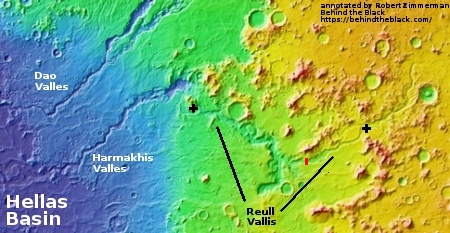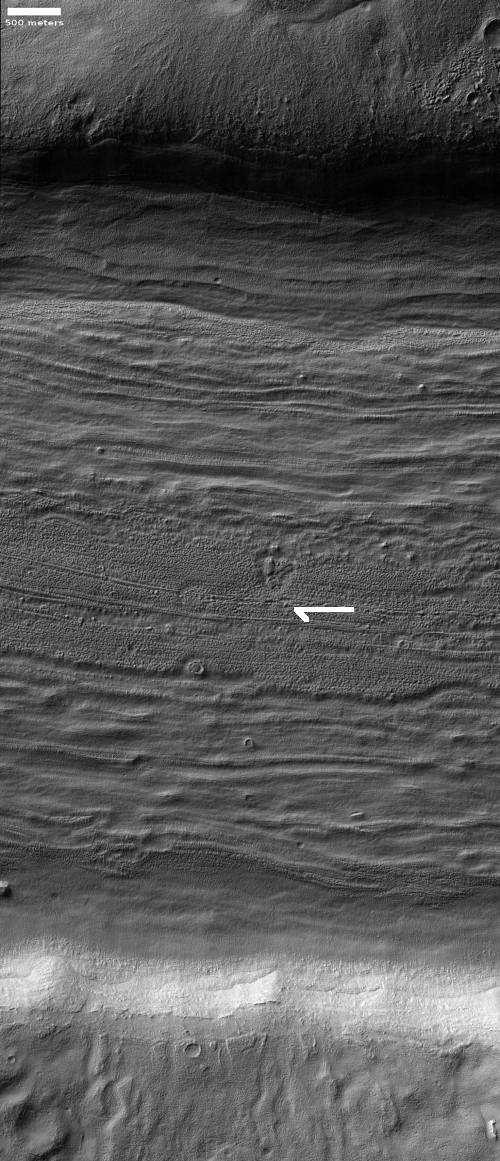A Martian river of ice
Cool image time! The photo to the right, rotated, cropped and reduced to post here, was taken on May 13, 2021 by the high resolution camea on Mars Reconnaissance Orbiter (MRO). It spans the entire 4.7 mile width of the southern hemisphere canyon dubbed Reull Vallis. The white arrow indicates the direction of the downhill grade
The scientists title this image “Lineated Valley Fill.” The vagueness of this title is because they have not yet confirmed that this lineated valley fill is a glacier flowing downhill to the west.
Nonetheless, the material filling this valley has all the features one expects glaciers to exhibit. Not only is the the lineation aligned with the flow, it varies across the width of the canyon as glaciers normally do. At the edge the parallel grooves are depressed, probably because they are torn apart by the canyon walls as the glacier flows past. In turn, at the center of the flow the grooves are thinner and more tightly packed, and appear less disturbed. Here, the flow is smooth, less bothered by surrounding features.
This pattern also suggests the merging of two flows somewhere upstream.
A glance at the spectacular Concordia glacier in the Himalayas near the world’s second highest mountain, K2, illustrates the similarity of this Martian feature to Earth glaciers.
Reull Vallis itself flows down to Hellas Basin, the deepest basin on Mars. As it meanders downhill along its 650 mile length it steadily gets wider and less distinct as it drops into Hellas. Along its entire length MRO has photographed numerous similar examples of this lineated fill, all suggesting that under a thin layer of debris is a thick glacier, slowerly carving this canyon out.
The overview map below illustrates these facts nicely, while further reinforcing these glacial conclusions.

The small red rectangle in the center marks the location of today’s image. The two black crosses indicate earlier cool image posts (here and here), both of which exhibited similar glacial-like flow features.
In addition to the two other images mentioned above, I have highlighted many other glacial features in Reull Vallis. For example, an MRO image just to the west of this one and posted in October 2020 shows similar lineated features.
Do a search on Behind the Black for “Reull” and you will see plenty of cool images that say this canyon was carved by glaciers, not flowing water.
On Christmas Eve 1968 three Americans became the first humans to visit another world. What they did to celebrate was unexpected and profound, and will be remembered throughout all human history. Genesis: the Story of Apollo 8, Robert Zimmerman's classic history of humanity's first journey to another world, tells that story, and it is now available as both an ebook and an audiobook, both with a foreword by Valerie Anders and a new introduction by Robert Zimmerman.
The print edition can be purchased at Amazon or from any other book seller. If you want an autographed copy the price is $60 for the hardback and $45 for the paperback, plus $8 shipping for each. Go here for purchasing details. The ebook is available everywhere for $5.99 (before discount) at amazon, or direct from my ebook publisher, ebookit. If you buy it from ebookit you don't support the big tech companies and the author gets a bigger cut much sooner.
The audiobook is also available at all these vendors, and is also free with a 30-day trial membership to Audible.
"Not simply about one mission, [Genesis] is also the history of America's quest for the moon... Zimmerman has done a masterful job of tying disparate events together into a solid account of one of America's greatest human triumphs."--San Antonio Express-News
Cool image time! The photo to the right, rotated, cropped and reduced to post here, was taken on May 13, 2021 by the high resolution camea on Mars Reconnaissance Orbiter (MRO). It spans the entire 4.7 mile width of the southern hemisphere canyon dubbed Reull Vallis. The white arrow indicates the direction of the downhill grade
The scientists title this image “Lineated Valley Fill.” The vagueness of this title is because they have not yet confirmed that this lineated valley fill is a glacier flowing downhill to the west.
Nonetheless, the material filling this valley has all the features one expects glaciers to exhibit. Not only is the the lineation aligned with the flow, it varies across the width of the canyon as glaciers normally do. At the edge the parallel grooves are depressed, probably because they are torn apart by the canyon walls as the glacier flows past. In turn, at the center of the flow the grooves are thinner and more tightly packed, and appear less disturbed. Here, the flow is smooth, less bothered by surrounding features.
This pattern also suggests the merging of two flows somewhere upstream.
A glance at the spectacular Concordia glacier in the Himalayas near the world’s second highest mountain, K2, illustrates the similarity of this Martian feature to Earth glaciers.
Reull Vallis itself flows down to Hellas Basin, the deepest basin on Mars. As it meanders downhill along its 650 mile length it steadily gets wider and less distinct as it drops into Hellas. Along its entire length MRO has photographed numerous similar examples of this lineated fill, all suggesting that under a thin layer of debris is a thick glacier, slowerly carving this canyon out.
The overview map below illustrates these facts nicely, while further reinforcing these glacial conclusions.

The small red rectangle in the center marks the location of today’s image. The two black crosses indicate earlier cool image posts (here and here), both of which exhibited similar glacial-like flow features.
In addition to the two other images mentioned above, I have highlighted many other glacial features in Reull Vallis. For example, an MRO image just to the west of this one and posted in October 2020 shows similar lineated features.
Do a search on Behind the Black for “Reull” and you will see plenty of cool images that say this canyon was carved by glaciers, not flowing water.
On Christmas Eve 1968 three Americans became the first humans to visit another world. What they did to celebrate was unexpected and profound, and will be remembered throughout all human history. Genesis: the Story of Apollo 8, Robert Zimmerman's classic history of humanity's first journey to another world, tells that story, and it is now available as both an ebook and an audiobook, both with a foreword by Valerie Anders and a new introduction by Robert Zimmerman.
The print edition can be purchased at Amazon or from any other book seller. If you want an autographed copy the price is $60 for the hardback and $45 for the paperback, plus $8 shipping for each. Go here for purchasing details. The ebook is available everywhere for $5.99 (before discount) at amazon, or direct from my ebook publisher, ebookit. If you buy it from ebookit you don't support the big tech companies and the author gets a bigger cut much sooner.
The audiobook is also available at all these vendors, and is also free with a 30-day trial membership to Audible.
"Not simply about one mission, [Genesis] is also the history of America's quest for the moon... Zimmerman has done a masterful job of tying disparate events together into a solid account of one of America's greatest human triumphs."--San Antonio Express-News



Are the distances between lineation (correct?) as expected with a 1/3 gravity planet?
There appear to be craters in the flow, or at least, circular formations. If it’s a glacier, the progress is ‘glacial’, even by that standard.
Blair K Ivey: It is presently believed that the glaciers on Mars are not active, at least in this region. With no additional material being placed at their upstream ends, they are not being pushed forward.
There is something on earth called a rock glacier. As a normal glacier begins to melt, slowly, talus accumulates on the top. This talus becomes thick enough to insulate the underlying glacier. They usually occur when the glacier has a very low flow velocity, which is confirmed by the craters we see. Also the craters, if small enough, might be carried along, since they are largely in rock, not the underlying ice.
Under the rock it is likely a mix of rock and ice, having more ice toward the bottom. These features could be tens of thousands of years old. On Mars, maybe millions of years.
Amazing
I forgot to add – the beauty of glaciers is they preserve a tremendous amount of information on climate. Imagine what an rock glacier ice core from mars could tell us!
1) Whether life exists or existed.
2) Climatic cycles on mars. Do they match up with the Earth? During what period?
3) A record of volcanic activity.
5) A record of major impact events.
6) Captured historic samples of the atmosphere.
7) Past air temps.
8) ????? something new and different.
Geoman: I think you are new here. If so, so a search on Behind the Black for “glaciers.” If you think this image is amazing you might find the wealth of other glacial data on Mars to be of interest.
Robert:
Even if no new material is introduced upstream, I would think the weight of material would flatten the glacier, so that it resembled an alluvial plain in the valley. But at 0.3g, maybe these things take time.
” …. A glance at the spectacular Concordia glacier in the Himalayas … ”
Wow, I followed that link to my great surprise.
That is some spectacular geography !!
Great photos.